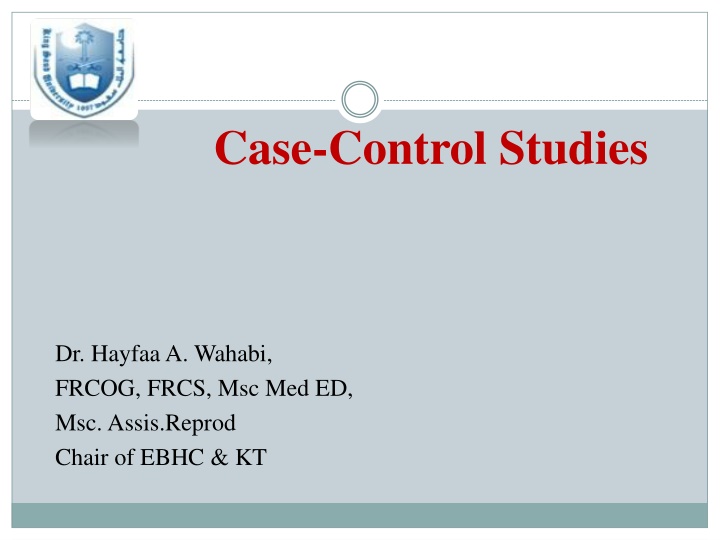
Case-Control Studies in Epidemiology
Explore the fundamentals of case-control studies in epidemiology, including the design, objectives, and applications. Learn the relevance of this research method for investigating rare diseases, identifying risk factors, and addressing ethical considerations in research. Discover how case-control studies provide valuable insights into disease etiology and the advantages they offer in certain scenarios.
Uploaded on | 1 Views
Download Presentation

Please find below an Image/Link to download the presentation.
The content on the website is provided AS IS for your information and personal use only. It may not be sold, licensed, or shared on other websites without obtaining consent from the author. If you encounter any issues during the download, it is possible that the publisher has removed the file from their server.
You are allowed to download the files provided on this website for personal or commercial use, subject to the condition that they are used lawfully. All files are the property of their respective owners.
The content on the website is provided AS IS for your information and personal use only. It may not be sold, licensed, or shared on other websites without obtaining consent from the author.
E N D
Presentation Transcript
Case-Control Studies Dr. Hayfaa A. Wahabi, FRCOG, FRCS, Msc Med ED, Msc. Assis.Reprod Chair of EBHC & KT
Case-Control Studies Objectives: After this session, you will be familiar with: The basic design of a case-control study The type of research questions for which the case- control study is used. Measurement of association in case-control studies. The advantages and limitations of case-control studies Example of applications of case-control designs
Definition: Case Control Study Analytic epidemiologic research design The study population consists of groups : Cases (with the disease) Controls (do not have the disease under study) The investigator measures/ inquires for exposure/s from cases and controls using questionnaires If exposure is related to disease its proportion will be higher in cases compared to controls
Design of Case-Control Studies The investigator selects cases with the disease, and appropriate controls without the disease and obtains data regarding past exposures to possible etiologic factors in both groups. The investigator then compares the frequency of exposure of the two groups.
Case-Control Design Risk factor present Cases (diseased) Risk factor absent Risk factor present Controls (no disease) Risk factor absent Study begins here present Past exposures Ascertaining exposure time
The type of research questions in case-control study design 1. Rare diseases, unexplained illnesses 2. When experimental trials (e.g. RCT) are not ethical or feasible, (lung cancer and smoking) 3. When cohort studies are expensive or non- feasible e.g. (to investigate etiology of rare disease e.g. cancer)
Other considerations 3. When funding and time constraints are not compatible with a cohort study. 4. Case ascertainment system in place: The conduct of a case-control study may be facilitated by the availability of a case-ascertainment system e.g. a) Population-based cancer registry b) Hospital-based surveillance systems
Selection of cases Definition of cases is the first task of the investigator in case control studies. Case ascertainment is important through hospital records and specific investigations. It is often recommended to choose incident (newly diagnosed) cases because exposure is recent and easy to recall. Recall could be a major problem for cases and controls
Biases in Case Control Study Recall bias for ascertaining past exposures Selection bias due to selection process of cases and controls Bias due to confounders
Recall Bias: major problem Cases tend to recall small exposures (being diseased) and controls tend to forget their important exposures e.g. case control study of congenital disorders; mothers of neonates with congenital abnormality will recall minute details of exposures during pregnancy compared to mothers of healthy neonates
Sources of cases 11 Cases admitted to or discharged from a hospital, clinic or any health care facility. Cases reported or diagnosed during a survey or surveillance system Incident cases in a going cohort study Death certificates with recorded cause of death. Employment records. Institutional records
SELECTION OF CONTROLS It is crucial to set up control group (s) from people who are certain not to have got the specified disease/condition. The aim of the control group is to compare the exposure rate among both cases and controls (% smoking among cases and controls)
Sources of control 13 Hospital controls Advantages of hospital controls: Subjects are easily accessible. Patients usually have time to participate. Patients are often motivated to cooperate with investigators.
Sources of control: cont 14 1-Hospital controls ..Advantages of hospital controls Controls and cases may be drawn from similar social and geographical environment. Differential recalls of prior exposure is likely to be minimized.
SOURCE OF CONTROL 15 Hospital controls Disadvantages of hospital controls: Differential hospitalization patterns may introduce selection bias. Difficult to blind disease status from cases and controls.
SOURCE OF CONTROL 16 1-Hospital controls ..disadvantages of hospital controls An underestimate of the study effect may be obtained if control s disease is etiologically similar to cases disease.
Sources of control 17 Community control: A probability sample of a defined population, if cases do belong to that population or a sample of relatives or associates of cases or neighborhood controls. Advantages of community controls Reduction of selection bias. Generalization of study results is more valid. May provide convenient control of extraneous variables.
Disadvantages of community controls 18 Time and money consuming. May suffer low participation rate. Cases and control may exhibit differential recall of prior exposures.
How many controls per case? 19 Ideal : 1 : 1 In case of Rare Cases (less # of cases then increase the number of controls to increase study power. up to 1 : 4 provides maximum power More than 4 controls per one case will not add much to study power
Then to confirm/refute if that the risk factor has occurred more frequently in the cases than in the controls using the measurement of association.
Analysis of case control study 21 Cases Controls Disease status A B Exposure Yes C D NO A+C B+D
Measures of association 22 Risk of Association can be estimated in case control studies by means of odds ratio (OR) which is the ratio of odds of exposure among diseased to the odds of exposure among controls.
Measures of association 23 Calculating Odds = (number exposed number unexposed) Odds (Cases) = A/C Odds (controls) = B/D Calculating Odds ratio or cross product ratio: Odds Ratio = (A/C) / (B/D) = AD/BC
Example of Case Control Study 24 Cases Controls Other illnesses/ Free of any illness Myocardial infarction (MI) EXPOSED NOT EXPOSED EXPOSED NOT EXPOSED SMOKED NEVER SMOKED SMOKED NEVER SMOKED Compare proportions of exposed in cases and controls 21/10/1446
Example of Case Control Study 25 Cases (MI) Controls Smokers 110 150 Never smokers 90 250 Total 200 400 % smokers If disease is related to smoking then more cases than controls would be smokers 55% 37.5%
Measures of association 26 Calculate Odds ratio (cross product ratio) Exposed Cases 110 Controls 150 Not exposed 90 250 OR= ad/bc = [(110X250)/(150X90)] = 27500/ 13500 = 2 Odds of exposure in cases : two times compared to controls
Interpretation of (OR) odds ratio 27 > 1: means the exposure is a risk factor. = 1: means the exposure is not associated with the disease. < 1: means the exposure is protective
Interpretation of (OR) odds ratio Interpretation of (OR) odds ratio OR>1 OR=1 OR<1 Odds of exposure for cases are less than the odds of exposure for controls Odds comparison between cases and controls Odds of exposure for cases are greater than the odds of exposure for controls Odds of exposure are equal among cases and controls Exposure as a risk factor for the disease? Particular exposure is not a risk factor Exposure reduces disease risk (Protective factor) Exposure increases disease risk (Risk factor)
How to interpretation of (OR) odds ratio from the previous example? The risk of Myocardial infarction (MI) is two times higher among smokers compared to non smokers. Smoking is a risk factor for MI
Advantages of case control study 30 1. Useful in study of rare diseases 2. Rapid evaluation of disease with a long latency. e.g. chronic diseases 3. Multiple exposures (risk factors) could be studied 4. Useful in early stages of the development of knowledge. 5. Does not require large samples and requires less money and personnel so it is efficient, quick and cheap.
Disadvantages of case control study 31 Not practical for rare exposures or long latency period of disease. Historical information often can not be validated and recall could be biased Relevant cofactors may be difficult to control. Selective survival may bias the comparison. Liable to different sources of bias, selection bias, recall bias, interviewer s bias.






